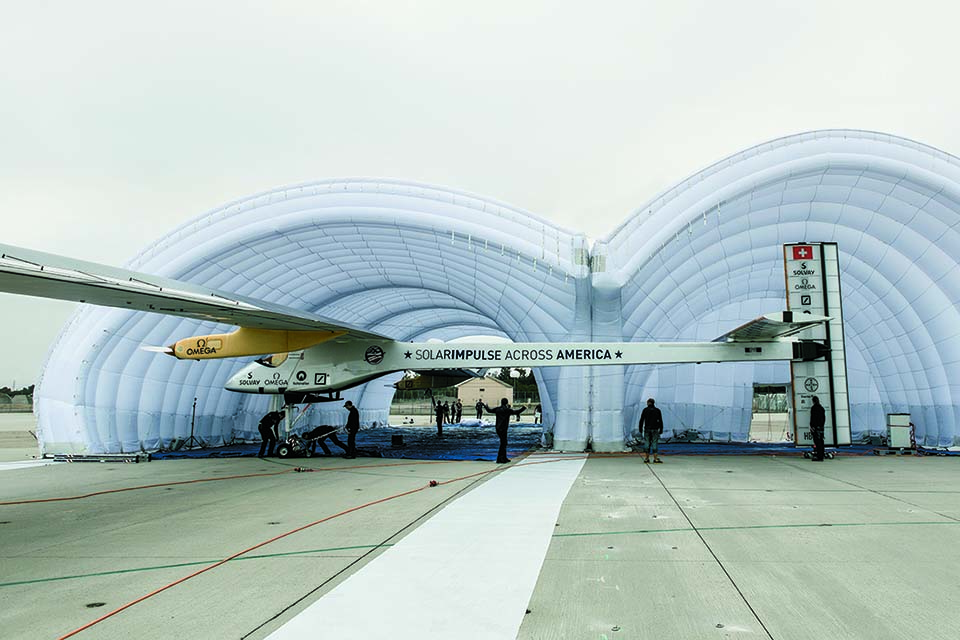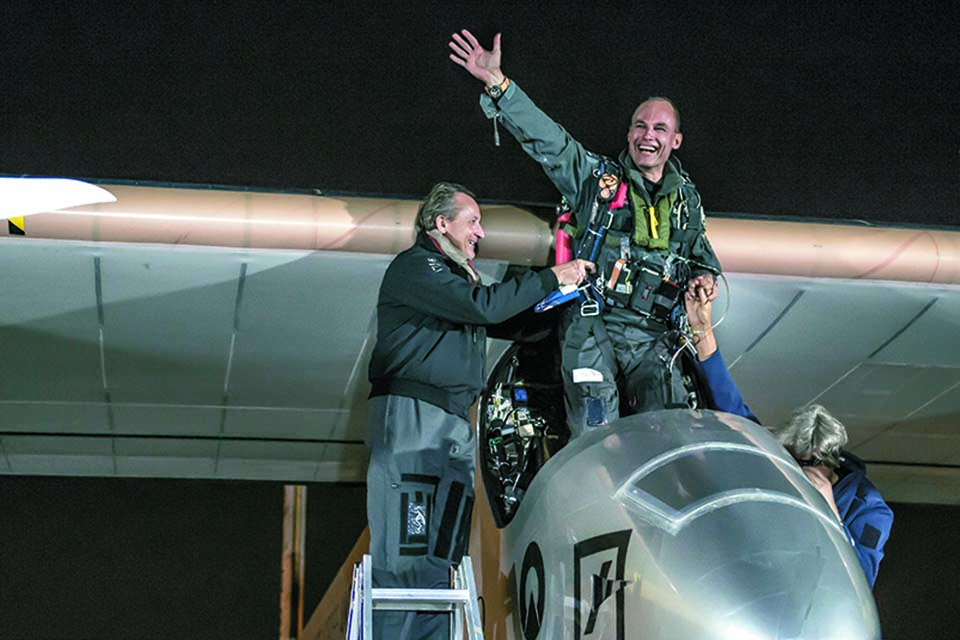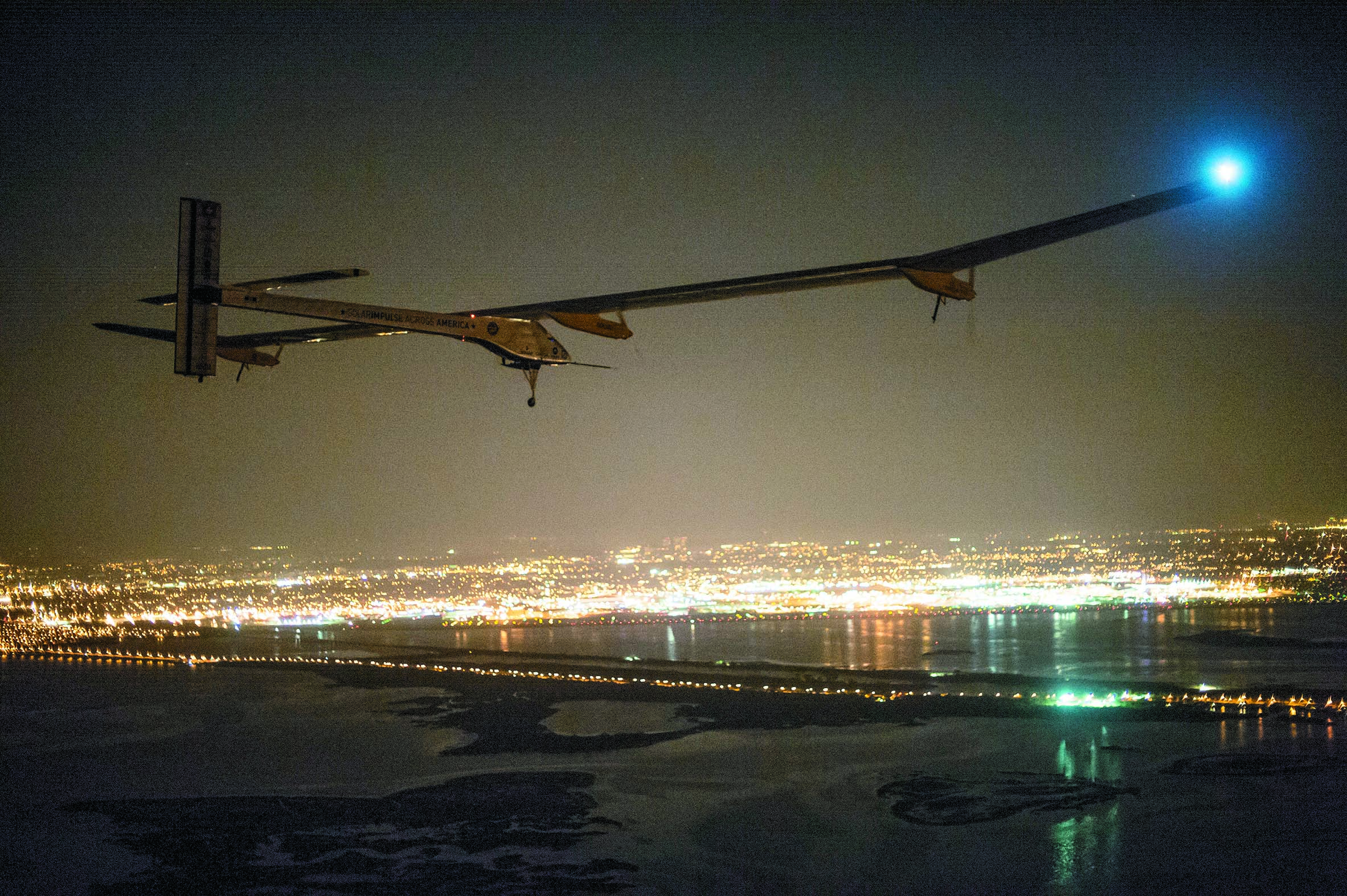“The more you fly, the more energy you have,” says André Borschberg. “In theory, the plane could fly forever.”
For a brief time on July 6, 2013, in the night-time sky just south of New York City, pilot André Borschberg and his partner on the ground, Dr. Bertrand Piccard, were forced to contemplate the unthinkable. Solar Impulse, the technologically extraordinary airplane fueled by about 12,000 solar cells splayed across its 208-foot wingspan, had developed an 8-foot tear in the fluoropolymer fabric under its left wing. There was no immediate danger; the tear made the cumbersome plane just a bit more difficult to pilot, but it was manageable. Still, there were a number of things to consider. For instance, use of the air brakes on landing might stress the wing beyond its tolerances. And air traffic control at JFK would need time to rearrange flight patterns (Borschberg wasn’t scheduled to land for at least three more hours)—no small task at one of the world’s busiest airports. A lot could still go wrong.
So…worst case scenario: Ditch the plane and bail out over the Atlantic Ocean?
Hearing the news even as it unfolded, I was reminded of what Piccard had told me just days before, during the team’s stopover at the National Air and Space Museum’s Udvar-Hazy Center at Dulles International Airport. “What if something goes wrong with the solar power system?” I asked him. “Is there some kind of fuel backup?”
Piccard laughed. “Oh no, there is no backup. If something goes wrong, well…” He smiled and shrugged.
Solar Impulse, trundling along at about 33 mph, was within hours of completing an epic journey across the United States begun a little over two months earlier in San Francisco. The series of flights, launched in early May, had taken almost 106 hours, with the two pilots alternating on each leg of the trip. Until now it had faced no particular structural or electrical problems; in fact, even weather played a factor only once, when the team was forced to add a leg from St. Louis to Cincinnati to avoid storm fronts en route to Dulles.

The Swiss-based team of Borschberg and Piccard possesses the unbridled enthusiasm and optimism required of visionaries. Borschberg, a former fighter pilot in the Swiss air force, is an MIT grad with expertise in mechanical engineering and thermodynamics. Piccard is a medical doctor and psychiatrist whose passion for aviation led him in 1999 to become the first to circle the world nonstop in a balloon. Given their diverse backgrounds, it comes as little surprise that they take in stride such problems as being confined, alone, to a small, narrow cockpit for 20 hours at a time, along with the immense quiet associated with flying a solar plane.
“Staying awake is not so much of a problem,” the indefatigable Piccard said during the Dulles layover. “You have to remember, we are flying this new, amazing technology. It’s very stimulating. The most challenging part of flying the plane is weather. It is such a big plane, flying so slowly. There is so much inertia to control.
“While you are in the cockpit it is almost silent,” he added. “There is no airplane in the world like it.”
“As a pilot, it’s just a gorgeous plane to fly,” Borschberg agreed. “The more you fly, the more energy you have. While you fly during the day you are building up energy to fly through the night. In theory, the plane could fly forever.
“There is just the little problem of having facilities for the pilot,” he quipped.
The pilots relied on specialized diets and, Piccard said, meditation techniques to remain alert. They were constantly monitored by physicians via a remote electrocardiogram system, roughly the size of a matchbox. Other technology, developed by Swisscom, sent dozens of data points to the ground, tracking temperature, position and relevant structural and motor information.
Ultimately, all the technology—not to mention pilot skill—added up to a successful, if very, very slow landing at JFK at 11:09 p.m. on July 6. “It was the most difficult landing [of the journey],” Borschberg said at a New York press conference, something of an understatement. “We had to think of all possible scenarios, including bailing out over the Atlantic. But it was an invaluable learning experience.”
The knowledge gained through the various legs of their trip will be put to good use: The Solar Impulse team plans to circumnavigate the globe in a modified version of the plane in 2015.
Meanwhile, the project is not so much about establishing aviation records (the Fédération Aéronautique Internationale notes they set at least five world records) as it is raising awareness about green technology. That emphasis was particularly evident during the team’s June visit to Dulles, where international dignitaries ranging from Swiss ambassador Manuel Sager to recently appointed U.S. Secretary of Energy Ernest Moniz were on hand.

“This project touches on four areas that are important to the Department of Energy,” Moniz said. “Solar energy, energy storage, energy efficiency and materials. This project is advancing solar technology in so many directions. Just a few years from now, people are going to be surprised at where solar energy is because of the various types of technology being put forward here today.”
Against the backdrop of aviation wonders at the Udvar-Hazy Center, ranging from the 1903 Langley Aerodrome A to the space shuttle Discovery, it was impossible to avoid the profound sense of being witness to a nexus point in history. “This airport is symbolically the most important point of the entire trip across the United States,” Piccard said. “Not only for the airplane itself crossing the continent, but for the message we would like to share with you.
“This project is not about André and me,” he said. “It took a family of 80 companies, most of which did not come from the aviation field.” Piccard noted that corporations such as Solvay, an international chemical group, developed plastics to make the plane lighter. Omega designed an ultra-light (less than 2 kilogram) landing system using LED lights protected by the same plastic used in Swatch-brand watches. And Bayer Material Science (part of the same group known for its aspirin) designed rigid foam insulation to help regulate temperatures in the cockpit. Even Nestlé got into the mix, providing personalized diets for the pilots.
“Until now people insisted there was no way to bring together industry with the protection of the planet,” Piccard said. “The two were always at odds. But this is proof that there are clean technologies available that can, at the same time, reduce energy consumption and create jobs.”
Originally published in the November 2013 issue of Aviation History. To subscribe, click here.





